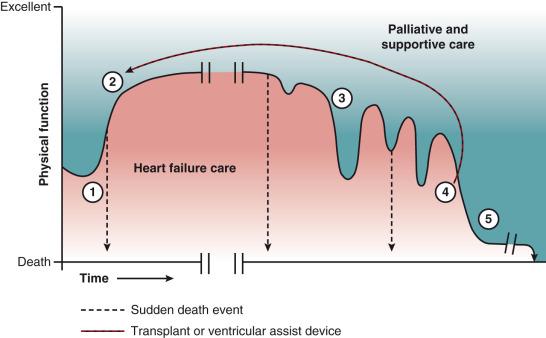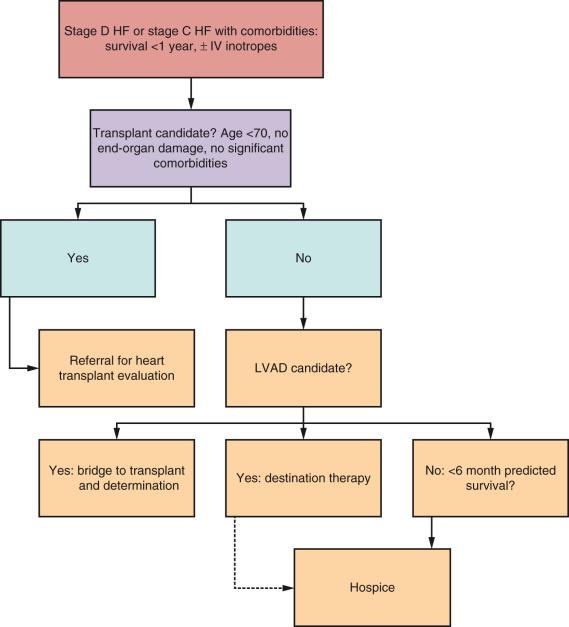Physical Address
304 North Cardinal St.
Dorchester Center, MA 02124
The burden of heart failure (HF) includes frequent deteriorations often requiring hospitalization, high mortality, and significant symptoms, reducing the quality of life. HF contributes to more than 10% of deaths in the United States. Despite advances in therapy, the number of deaths attributable to HF today is similar to the numbers in 1995. Patients who survive a hospitalization for HF have age-adjusted 28-day and 1-year case fatalities of 10.4% and 29.5%, respectively. After three or four hospitalizations for HF, patients older than 85 years and patients younger than 65 years have a 50% 6-month mortality rate.
Symptoms are prevalent throughout the course of HF; most HF hospitalizations are associated with increased dyspnea, fatigue, or other cardiovascular symptoms. Heart failure patients are predominantly elderly, most of whom have more than four comorbid conditions. Some patients with HF will be hospitalized for unrelated issues and HF management complicates their care. The majority of patients with chronic HF are also frail and may have cognitive impairment, complicating intensive care management. Communication and decision making with the patient and family should acknowledge mortality and address palliation in addition to life extension.
This chapter addresses palliative and end-of-life concerns encountered in the intensive care unit (ICU). Care for the patients with advanced HF who are without further options for advanced therapies is specifically addressed. Fig. 52.1 illustrates the trajectory of HF, incorporating palliative and care supportive throughout the course of the illness. HF results in severe impairment of function that might result in cardiac intensive care unit (CICU) admission, but appropriate medications and treatment often can rescue the patient. This chapter is particularly relevant to patients who do not recover with aggressive treatment (see Fig. 52.1 , time point 4), or who may no longer have options for advanced therapies (such as left ventricular assist device [LVAD] or transplant).

Approximately 5% to 10 % of all patients with HF have stage D disease ; a larger number of patients have stage C HF with significant comorbidities. Patients with American College of Cardiology/American Heart Association (ACC/AHA) stage D HF have refractory HF. These patients experience rest symptoms despite optimal medical management and are refractory to conventional therapy, which may also include advanced treatment strategies, such as inotropes or LVADs. Patients with ACC/AHA stage C HF who have significant comorbidities and complications (frailty, COPD, dementia) are also approaching the end of life. Life expectancy is limited for HF patients even when advanced therapies are used. Patients who receive cardiac transplant have an average 10-year survival and about 70% LVAD device recipients survive 2 years, though newer devices may improve length of life. Patients with HF and reduced left ventricular ejection fraction (HFrEF) receiving continuous inotropic support have an average 6-month survival. Options for an approach to patients in these groups are presented in Fig. 52.2 . Comprehensive HF management should weave in palliative interventions throughout the course of care for communication and shared decision making, including advanced care planning, and symptom management. When appropriate, end-of-life care should include hospice care.

Palliative care is a philosophy of care as well as a care delivery system that often employs a multidisciplinary team involving physicians, advanced care practitioners, nurses, social workers, and—most notably—the patient and the patient's family. All clinicians provide palliative care when suffering and the burden of illness are addressed. Palliative care emphasizes alleviation of physical, psychosocial, and spiritual symptom burden to enhance quality of life. Palliative care should be provided throughout the course of all serious illnesses, and does not necessitate end of life or a set prognosis. Palliative care consultation in the CICU results in increased referrals of patients to hospice. Hospice and palliative care often go hand in hand. Hospice is a model of care targeting those in the last 6 months of life, while palliative care is provided at any time and concurrently with life-prolonging treatment. Thus, in the CICU, palliative care and advanced treatment of HF are not mutually exclusive but instead are synergistic and beneficial to all stakeholders (patients, family, providers, and the hospital itself). We recommend early consultation of in-patient palliative care teams for patients with life-shortening illness. Clinicians based in the CICU provide many components of palliative care; however, when hospice referral is appropriate, palliative care consultants can facilitate continuity of care. Incidentally, ICU palliative care consultations benefit the health care system via reduced length of stay and cost saving of an estimated $7700 per hospitalization for HF.
Hospice care incorporates palliative care and supportive services 24 hours a day, 7 days a week. The majority of hospice care is delivered as intermittent visits in the home or patient's residence (including long-term care settings). The hospice benefit also includes “general inpatient care” for severe symptoms or crises that cannot be managed in the home, “continuous care” that delivers 8 to 24 hours of skilled care in the home for a few days to manage acute problems or provide training to caregivers, and respite care for the primary caregiver. Physical, social, spiritual, and emotional care are provided via an interdisciplinary team . Individuals who qualify for hospice have a likely life expectancy of 6 months or less. Patients are eligible for hospice via Medicare (and most other insurers) with two physician certifications of 6 months or less of life if the illness runs its natural course, although patients can be repeatedly certified for the hospice benefit when they live longer than 6 months. The patient must elect the hospice benefit and agree to not be hospitalized for the hospice diagnosis. More information can be obtained at https://www.medicare.gov .
When the hospice diagnosis is HF, the traditional guidelines include HF New York Heart Association (NYHA) class IV with either symptoms at rest or inability to carry out minimal activities due to dyspnea despite optimal medical treatment. These criteria are outdated and serve more as a guideline, as more weight is given to the physician's statement regarding prognosis based on the complexity of HF, including the number of associated hospitalizations; decline in self-care; frailty; and other comorbidities, such as cancer or markers of disease severity, including hyponatremia, elevated N-terminal prohormone brain natriuretic peptide (NT-proBNP), cachexia, and use of inotropes.
The American Heart Association/American College of Cardiology (AHA/ACC) 2013 and the European Society of Cardiology (ESC) 2013 HF guidelines recommend ongoing discussion with patients and families about prognosis for functional capacity and survival, palliative and hospice care, and discussions regarding implanted device deactivation. Ideally, these topics should be addressed throughout the course of the patient's HF progression, and should be readdressed with changes in clinical status. Patients and their families may also request to have these discussions. Fig. 52.2 provides a decision tree, with various branch points when hospice might be considered. Several risk models can assist with prognostication. We suggest that clinicians identify which model is most useful for the specific patient and circumstance at hand, bearing in mind that the tools reflect aggregate data and provide only estimates. Table 52.1 lists prognostic models and their characteristics. One out of five patients do not want to know their prognosis; thus it is important to begin communication by asking what the patient wants to know.
| Model | Outcome | Variables, Limitations, Advantages | Example Patient | Survival vs. Mortality |
|---|---|---|---|---|
| Seattle Heart Failure Model | Continuous risk score expressed as predicted life expectancy and percentage chance of survival (1-, 2-, and 5-year mortality) | Accounts for NYHA functional class, ischemic etiology, diuretic dose, LVEF, SBP, sodium, hemoglobin, percent lymphocytes, uric acid, cholesterol. Not derived from HF population. Most commonly used, validated in HF patients | 65 yo male w/ ischemic cardiomyopathy; EF 30%; NYHA class IV; SBP 90; on ACEi, BB, statin; with ICD in place | 1-year mortality, 11%; 2-year, 20%; 5-year, 43% |
| Heart Failure Survival Score | All-cause mortality | Peak VO 2 , LVEF, serum Na, mean BP, HR, ischemic etiology, QRS duration/morphology Limitation: difficult to acquire VO 2 data |
LVEF 40%; SBP 90; serum Na 135; known ischemic cardiomyopathy; IVCD of 124 ms; resting HR of 90 beats/min (VO 2 max not known) | Score: 7.25 Medium risk: 72% predicted 1-year survival |
| Inpatient Models for Heart Failure Prognostication | ||||
| EVEREST Risk Model | Combined endpoint mortality or persistently poor QOL over 6 months postdischarge | Age, DM, h/o stroke, h/o arrhythmia, BB use, BUN, Na, BNP, KCCQ score | ||
| EFFECT | 30-day and 1-year mortality | Age, SBP, RR, Na, hemoglobin, BUN, h/o CVA, h/o dementia, h/o COPD, h/o cirrhosis, h/o cancer Limitation: no EF requirement |
Predicted 30-day survival for 62 yo male, RR, 20 beats/min; SBP, 100 mm Hg; BUN, 30; hemoglobin, 10; serum Na, 132; + CVD + COPD + dementia | Score: 122 High risk: 26%–32.7% 30-day mortality |
| ADHERE | In-hospital mortality | BUN, SBP, serum Cr Limitation: no EF requirement |
Mean BUN <43 mg/dL; SBP <115 mm Hg; intermediate risk 3%–5.5% in-hospital mortality Compared to mean BUN >43 mg/dL, SBP <115 mm Hg, serum Cr >2.75 mg/dL | High risk Predicted in-hospital mortality: 21.9% |
| ESCAPE Discharge | 6-month mortality | BNP, CPR, or mechanical ventilation during hospitalization, BUN, Na, age >70 y, loop diuretic use, BB use, 6-min walk distance | 75 yo male, BUN >40, 6-min walk <300 ft, Na >130 mEq, no h/o CPR/mechanical ventilation, on 40 mg furosemide BID, not tolerating BB, with BNP 650 pg/mmol | Score: 5 Predicted 6-month mortality: 66.4% |
Become a Clinical Tree membership for Full access and enjoy Unlimited articles
If you are a member. Log in here